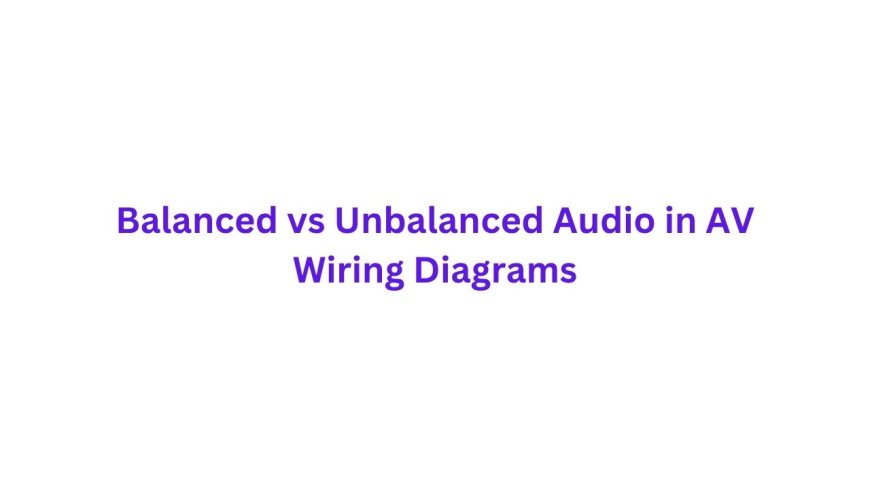Balanced vs Unbalanced Audio in AV Wiring Diagrams
This blog will explore the fundamental differences between balanced and unbalanced audio, how they are represented in AV wiring diagrams, and which scenarios are ideal for each type.

In the world of professional AV design, XTEN-AV stands at the forefront, offering streamlined tools for planning, designing, and implementing complex audio visual setups with ease. One crucial aspect that often surfaces during the AV planning process is the choice between balanced and unbalanced audio. Understanding the difference is essential for anyone working with V Wiring Diagrams, as it directly impacts signal integrity, sound quality, and overall system performance.
This blog will explore the fundamental differences between balanced and unbalanced audio, how they are represented in AV wiring diagrams, and which scenarios are ideal for each type. Whether you are an AV integrator, systems designer, or business owner planning a new installation, knowing when and how to use balanced vs unbalanced connections will save you time and money while ensuring optimal audio performance.
Introduction to Audio Signal Types
Audio signals travel from source equipment to amplifiers, speakers, or other devices through cables. These cables can carry the signal in two primary ways: balanced and unbalanced. The key difference lies in how the signal is transmitted and how susceptible it is to interference.
In AV installations, particularly when drafting V Wiring Diagrams, the type of audio signal being carried can dictate the choice of cable, connector type, grounding method, and even the positioning of equipment. Therefore, understanding balanced and unbalanced signals is not just a technical detail—it is a design necessity.
What Is Unbalanced Audio?
Unbalanced audio is the simpler of the two and is often used in consumer-level AV equipment. It involves two conductors inside the cable:
-
Signal wire – carries the audio signal
-
Ground wire – serves as the return path and shielding
The downside of unbalanced audio is its vulnerability to electromagnetic interference (EMI) and radio frequency interference (RFI). When signals travel over longer distances (typically over 15-20 feet), noise can get introduced, resulting in hums, buzzes, or degraded audio quality.
Common connectors: RCA, 3.5mm TRS (used in headphones), and 1/4-inch TS
Ideal for: Short cable runs in residential AV setups, personal devices, or within a rack where cable runs are minimal.
What Is Balanced Audio?
Balanced audio uses three conductors:
-
Positive (hot) – carries the original signal
-
Negative (cold) – carries an inverted version of the signal
-
Ground – provides shielding
The magic happens at the receiving end. The device flips the inverted signal back to its original form and combines it with the original signal. Any noise that was picked up along the cable run is canceled out because it affected both the positive and negative signals equally.
Common connectors: XLR, 1/4-inch TRS (used for pro audio)
Ideal for: Long cable runs in commercial environments like conference rooms, boardrooms, auditoriums, and stadiums.
Visualizing Balanced and Unbalanced Audio in V Wiring Diagrams
When creating AV wiring diagrams using XTEN-AV or other platforms, it is important to properly represent the audio path and type of signal. Balanced audio lines are usually marked with differential symbols or labels such as “+”, “-”, and “GND” to indicate the three-wire system. In contrast, unbalanced lines are shown with just a signal and ground path.
Proper labeling helps in:
-
Preventing signal mismatches
-
Simplifying future troubleshooting
-
Ensuring compatibility during installation
XTEN-AV’s advanced features allow designers to easily toggle between signal types and cable lengths, giving instant insights into whether balanced lines are needed to mitigate potential interference.
Key Differences at a Glance
| Feature | Balanced Audio | Unbalanced Audio |
|---|---|---|
| Number of Conductors | 3 | 2 |
| Noise Resistance | High | Low |
| Maximum Recommended Length | Up to 1000 ft | Up to 20 ft |
| Common Connectors | XLR, TRS | RCA, TS, 3.5mm |
| Ideal Usage | Commercial AV | Residential AV |
Real-World Applications
Scenario 1: Conference Room Setup
In a small to medium-sized conference room, the microphone and ceiling speakers may be 25 feet apart. Using unbalanced cables in this situation could lead to humming, especially if other electronic devices are nearby. Balanced audio is the better choice and should be clearly specified in your V Wiring Diagrams.
Scenario 2: Sports Bar Audio System
A sports bar with multiple TVs and speaker zones spread across a large area needs long cable runs. Here, balanced audio ensures that the game commentary is clear and free of noise, no matter the distance between the source and speakers.
Scenario 3: Home Theater Setup
In a home setup where all devices are located within a single media rack and cable runs are short, unbalanced cables will suffice and reduce complexity and cost.
Mixing Balanced and Unbalanced Connections
Sometimes, AV systems require both balanced and unbalanced connections. Special care is needed in such cases. Improper mixing can lead to signal loss, noise, or even equipment damage. XTEN-AV’s smart AV design platform lets you simulate and test signal paths virtually, allowing you to validate connections before physical implementation.
Pro tip: Use DI (Direct Injection) boxes or line level shifters when you need to convert unbalanced signals to balanced and vice versa.
How XTEN-AV Simplifies the Process
XTEN-AV’s platform is designed to support the creation of precise and professional V Wiring Diagrams. Users can select signal types, visualize cable paths, label connector types, and estimate cable lengths. This helps AV integrators avoid common pitfalls associated with mismatched audio signals, reduce field troubleshooting, and speed up installations.
With features like real-time signal validation, drag-and-drop templates, and automatic diagram generation, XTEN-AV ensures that both balanced and unbalanced audio paths are clearly and correctly represented.
Conclusion
Choosing between balanced and unbalanced audio is not just a technical choice—it is a strategic design decision that impacts performance, reliability, and cost. For AV designers, understanding these differences is essential when drafting accurate V Wiring Diagrams, especially for corporate, commercial, or multi-zone systems.
With the help of tools like XTEN-AV, you can confidently select and document the right audio paths, ensuring high-quality sound delivery regardless of the complexity of your AV setup. Whether you're wiring a boardroom or designing a campus-wide AV network, always let signal integrity guide your design.
What's Your Reaction?
 Like
0
Like
0
 Dislike
0
Dislike
0
 Love
0
Love
0
 Funny
0
Funny
0
 Angry
0
Angry
0
 Sad
0
Sad
0
 Wow
0
Wow
0






























